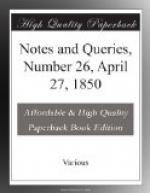F.R.A.
April 12. 1850.
Lollius.—In answer to “J.M.B.” (No. 19. p. 303.) as to who was the Lollius spoken of by Chaucer, I send you the following. Lollius was the real or fictitious name of the author or translator of many of our Gothic prose romances. D’Israeli, in his admirable Amenities of Literature, vol. i. p. 141., says:—
“In some colophons of the prose romances the names of real persons are assigned as the writers; but the same romance is equally ascribed to different persons, and works are given as translations which in fact are originals. Amid this prevailing confusion, and these contradictory statements, we must agree with the editor of Warton, that we cannot with any confidence name the author of any of these prose romances. Ritson has aptly treated these pseudonymous translators as ‘men of straw.’ We may say of them all, as the antiquary Douce, in the agony of his baffled researches after one of their favourite authorities, a Will o’ the Wisp named LOLLIUS, exclaimed, somewhat gravely,—’Of Lollius it will become every one to speak with diffidence.’”
Perhaps this “scrap” of information may lead to something more extensive.
EDWARD F. RIMBAULT.
Henry Ryder, Bishop of Killaloe (No. 24. p. 383).—Henry Ryder, D.D., a native of Paris, and Bishop of Killaloe, after whose paternity “W.D.R.” inquires, was advanced to that see by patent dated June 5. 1693 (not 1692), and consecrated on the Sunday following in the church of Dunboyne, in the co. Meath. See Archdeacon Cotton’s Fasti Ecclesiae Hibernicae, vol. i. p. 404., who gives an account of his family.
W.(I.)
Brown Study (No. 22. p. 352.).—Surely a corruption of brow-study, brow being derived from to old German, braun, in its compound form ang-braun, an eyebrow. (Vide Wachter, Gloss. Germ.)
HENNES
Seven Champions of Christendom.—Who was the author of The Seven Champions of Christendom?
R.F. JOHNSON.
[The Seven Champions of Christendom, which Ritson describes as “containing all the lies of Christendom in one lie,” was written by the well-known Richard Johnson. Our correspondent will find many curious particulars of his various works in the Introduction which Mr. Chappell has prefixed to one of them, viz. The Crown Garland of Golden Roses, edited by him from the edition of 1612 for the Percy Society.] {419}
“Tempora mutantur nos et mutamur in illis.”—“E.V.” (p. 215.) is referred to Cicero De Officiis, lib. i. cap. 10., and Ovid, Met. lib. xv. 165. et seqq.
“Vox Praeterea nihil.”—“C.W.G.” (p. 247.) is also referred to Ovid, Met. lib. iii. 397., and Lactantius, lib. iii. Fab. v. These are the nearest approximations I know.




